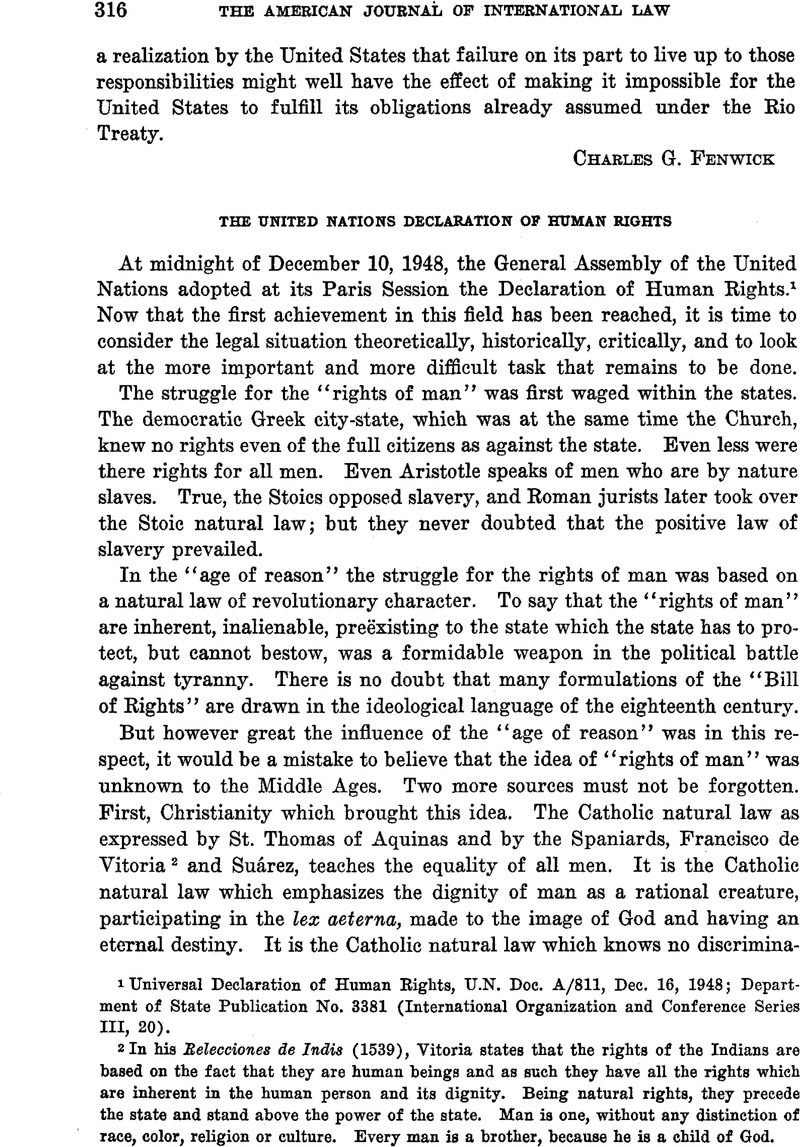Article contents
The United Nations Declaration of Human Rights
Published online by Cambridge University Press: 20 April 2017
Abstract

- Type
- Editorial Comment
- Information
- Copyright
- Copyright © American Society of International Law 1949
References
1 Universal Declaration of Human Rights, U.N. Doc. A/811, Dec. 16, 1948 ; Department of State Publication No. 3381 (International Organization and Conference Series III, 20).
2 In his Relecciones de Indis (1539), Vitoria states that the rights of the Indians are based on the fact that they are human beings and as such they have all the rights which are inherent in the human person and its dignity. Being natural rights, they precede the state and stand above the power of the state. Man is one, without any distinction of race, color, religion or culture. Every man is a brother, because he is a child of God.
3 ‘‘Homo non ordinatur ad communitatem poUtieam secundum se totum et secundum omnia sua . . . sed totum quod homo est ordinatur ad Deum’’ (I-II, qu. XXI, 4, 3), written as if to reject National Socialist “Gleichschaltung.”
4 E.g., the battle against the slave trade, the League of Nations efforts against slavery, the system of an international protection of national, religious and linguistic minorities, created after “World War I.
5 Even in 1929 the Institut de Droit International adopted a Declaration of the International Bights of Man (Annuaire, Session de New Torb, pp. 298-300).
6 See President Boosevelt’s ‘ ‘ Pour Freedoms, ’ ’ point 8 of the Atlantic Charter ; Essential Human Rights (“The Annals,” 1946); Commission to Study the Organization of Peace, Bill of Human Rights (International Conciliation, 1946, No. 426).
7 For an excellent, sober and strictly legal analysis see Jacob Eobinson, Human Rights and Fundamental Freedoms in the Charter of the U. N. A Commentary (New York, 1946). See also: Brunet, René, La garantie internationale des droits de l’homme d’après la charte de San Francisco (Geneva, 1947)Google Scholar; Partsch, Karl J., “Internationale Menschenrechte” in Archiv des öffentlichen Bechts, Vol. 74, No. 2 (July, 1948), pp. 158-190 Google Scholar.
8 That the members of the U. N. already have a certain legal obligation under the preamble and Arts. 1 and 55 of the Charter was stated by Judge J. M. MacKay, Superior Court of Ontario, in the case Re Drummond Wren (1945, Ont. R. 778). See also Sayre, P., “Shelley v. Kraemer and United Nations Law,” Iowa Law Review, Vol. 34, No. 1 (Nov. 1948), pp. 1-11 Google Scholar.
9 Jessup, Philip C., A Modern Law of Nations (New York, 1948), Ch. IV (pp. 68-93), at pp. 87 ffGoogle Scholar.
10 John P. Humphrey, in ‘‘ The Annals, ’ ’ January, 1948, pp. 15-16.
11 Kelsen, H., General Theory of Law and State (Cambridge, Mass., 1945), pp. 266-267 Google Scholar.
12 Lauterpacht, H., An International Bill of Rights (New York, 1945)Google Scholar; idem, “International Protection of Human Rights,” Hague Academy of International Law, Becueil des Cours, 70 (1947), Vol. I.
13 Verdross, A., “Die Internationale Anerkennung der Menschenrechte,” in Moser, , Weltbild and Menschenbild (1948), pp. 229-234 Google Scholar.
14 In this sense now Legaz y Lacambra, Jules Dabin, E. Brunner, Coing.
15 For a survey, see Year Book on Human Rights for 1946 (Lake Success, N. Y. : United Nations, 1948).
16 There are economic thinkers like Hayek (London) and Röpke (Geneva) who firmly believe that any “planned economy” is necessarily the “road to serfdom.” See, on this problem, recently Albert Lauterbach, Economic Security and Individual Freedom. Can We Have Both (Ithaca, N. Y.)
17 Statement by Mrs. Franklin D. Roosevelt on Dec. 9, 1948, Department of State Bulletin, Vol. XIX, No. 494 (Dec. 19, 1948), pp. 751-752.
18 Final Act, p. 48.
- 17
- Cited by


